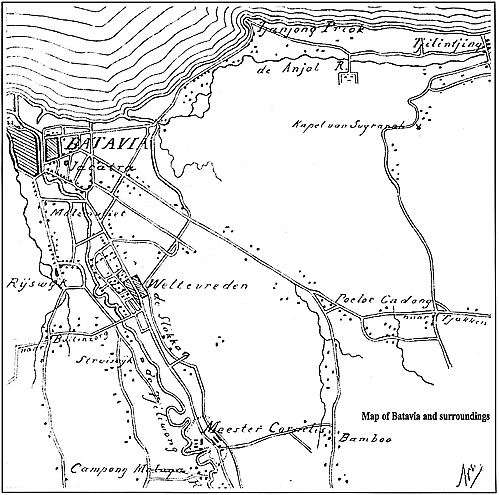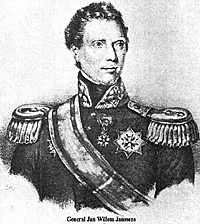General Jan Willem Janssens
Dutch Generals
Of The Napoleonic Wars
Introduction and Early Career to 1810
by Geert van Uythoven, The Netherlands
| |
This time I have decided to write about a lesser-known general, in reaction to a question about him asked on the First Empire Forum ‘Le Moniteur’ a few weeks ago. Lesser known, his presence and actions were by no means insignificant, as you will notice.
Jan Willem [2] Janssens was born on 12 October 1762 in the city Nijmegen in the eastern part of the Dutch Republic. His military career began when he was nine years old, when he entered the Dutch army as a cadet in the infantry Regiment ‘Van Aylva’ in 1771. The regiment renamed ‘Van Burmania’ on 24 December 1772, Janssens entered ‘real’ service when he was eleven years old, March 1775. His presence with the regiment lasted longer as its colonels; on 12 September the regiment was renamed ‘Prince Frederik van Oranje-Nassau’, and in this regiment Janssens became an ensign on 5 February 1777.
Again, the regiment was renamed, and became on 5 November 1784 Regiment No. 1 ‘De Schepper’. On 5 April 1785 Janssens became quartermaster of the 2nd battalion of his regiment. During the patriot rising in Holland in 1787, the regiment chose the side of the Stadtholder, and remained in the province Noord-Brabant during the Prussian invasion, missing action. [3]
Probably because of staying on the victorious side, on 31 December 1787 Janssens was promoted 1st lieutenant. However, finally he would leave the regiment, to become a captain on 12 December 1788, commanding the grenadier-company of the 2nd battalion / Infantry Regiment No. 18 ‘Van Pabst’. His rank became effective two years later, on 25 February 1790. Regarding the colonels, the same pattern continued; in April 1793 the regiment was renamed ‘Von Wartensleben’. Janssens served during 1793-‘94 with the regiment in Flanders, in the campaign against the French.
On 13 September 1793 he was wounded by a musket ball in his right shoulder, during the capture of Menin. He took part in the siege of Lanrécies (20-30 April 1794), and the battle of Fleurus on 26 June 1794.
After the defeat of the Dutch and British troops by the French in the beginning of 1795, the Dutch Republic was changed in the Batavian Republic, a French satellite state. The Batavian army was reorganised along French lines, and Janssens regiment, much depleted by the heavy fighting, became the 3rd battalion of the 1st Halve Brigade (‘Demi-Brigade’). However because of his wounds, received during the above campaign, Janssens was pensioned out of the standing army, and assigned to the administration of the French troops present in the Batavian
Republic on 16 June 1796. [4]
His administrative capabilities soon came to the surface, and already the next year, on 11 March 1797, Janssens became First-Commissary of the administration, and entrusted with a number of missions to France in 1797, 1798 and 1800. On 29 March 1800 he became
secretary of the Department of War, but resigned this post on 10 October 1800, staying advisor of the Agent of War. On 29 January 1801 he resumed the function as First-Commissary of the administration of the French troops in the Batavian Republic.
Following the Peace of Amiens on 25 March 1802, the Cape of Good Hope, captured by the British, would be returned to the Batavian Republic. Already during the preliminaries before the peace was signed, on 18 February 1802, 39 years old Janssens was appointed Governor-General and Commander in Chief of the Batavian colony at the Cape of Good Hope. He received the rank of Lieutenant General in the Batavian Army and a salary of 50,000 guilders, a big achievement for someone so young, even during this era, and in addition promoted from Captain to Lieutenant-General after having fulfilled only administrative functions!
Discharged honourable from his function as First-Commissary on 28 May, it would last until 5 August before he left for the Cape of Good
Hope, sailing on the ‘Bato’, part of the squadron commanded by Rear-Admiral Dekker. The squadron arrived at the roads of Capetown on 24 December 1802, and on 21 February 1803 Janssens took over government from the British. Expecting that peace would not last long, he immediately ordered defence works to be raised and existing ones strengthened. And as he expected, the Peace of Amiens was short-lived
and on 16 May the British declared war again. Janssens was however ordered to send most of his garrison to Java, which possession was estimated of more importance by the Batavian Government then the Cape of Good Hope.
All that was left to him were 1,900 men, Batavians and a battalion of the Regiment Waldeck in Batavian service, augmented by a few hundred
trained Hottentots. However, it took some time before the British would return.
Only on 4 January 1806, General Baird landed with 10,000 men at the Tafelbaai, near Capetown. Capetown, defended by the Waldeck
battalion, surrendered and was occupied by the British. Janssens retreated with about 1,500 men remaining, making himself no illusions about his chance to defeat the British. On 18 January, a battle was fought between the British invaders and Janssens, at the plain of Blauwberg. Janssens lost, receiving a concussion to his right hip by a musket ball during the battle, and was forced to capitulate on 23 January. Permitted to
leave for the Batavian Republic with his garrison on British ships Janssens left Capetown on 5 March. He arrived in his homeland at The Hague on 8 June 1806.
Things had changed during his absence. Napoleon had decided to abolish the Batavian Republic and to create the Kingdom of Holland, to be
ruled by his brother, Louis Napoleon, who would be known as Koning Lodewijk by the Dutch. King Louis, needing all the support he could get, immediately recognised the benefits he could get by winning over Janssens to his side.
Offered on 11 July 1806 to become Secretary-General of the Department of War, and Privy Council Extraordinary with the 4th Section
(‘War’) of the State Council [5] for the year 1806, Janssens had no reluctance to accept. One after the other, Janssens received and fulfilled a number of appointments, but saw no active duty: 24 September 1806, Quartermaster-General of the Expeditionary Army, destined for
Germany; 7 October, Quartermaster-General of the Army of the North in Germany under King Louis; 4 November, Governor-General
of Westphalia occupied by the Dutch troops; 15 December, Director-General of the war administration; 1 January 1807, Privy Council in normal service with the 3rd Section (‘War and Navy’) of the State Council for the year 1807, and on 6 March also Privy Council in normal service with the 4th Section (‘War’).
In addition, Janssens was distinguished for his good conduct by being appointed a Knight in the Koninklijke Orde van Verdienste
(‘Royal Order of Merit’) on 1 January 1807. [6]
On 28 May 1807 he was confirmed in his rank of Lieutenant-General on half-pay, receiving his payment from 19 January 1806. His career continued: on 26 June 1807 he was appointed President of the 3rd Section (‘War and Navy’) of the Sate Council, replacing Dirk van
Hogendorp, who fell in disgrace because of his pro-Napoleonic feelings.
Again Janssens was distinguished by being appointed Commander in the Koninklijke Orde der Unie on 25 November 1807. And again replacing Dirk van Hogendorp, Janssens became on 7 December Minister of War of the Kingdom of Holland.
As a Lieutenant-General he was pensioned on 1 January 1808. While continuing being Minister of War, in addition for the years 1808 and 1809 he was appointed Privy Council Extraordinary with the 3rd Section (‘War and Marine’) of the State Council. On 27 March 1809, Janssens was replaced as Minister of War because of his ill health. On his own request, because of the same reason, on 22 May of the same year he was pensioned as Minister of War, receiving a pension of 8,000 guilders, and retaining his rank as Lieutenant-General and his function as Privy Council Extraordinary.
 More General Jan Willem Janssens
The East Indies, 1811 The Final Years 1812-1838 Jumbo Map of Batavia (very slow: 266K) Back to Table of Contents -- First Empire #59 Back to First Empire List of Issues Back to MagWeb Master Magazine List © Copyright 2001 by First Empire. This article appears in MagWeb (Magazine Web) on the Internet World Wide Web. Other military history articles and gaming articles are available at http://www.magweb.com |

 A few years ago, I wrote an article about a well-known Dutch General, Herman Willem Daendels, who was Marshal of Holland for some time. [1]
A few years ago, I wrote an article about a well-known Dutch General, Herman Willem Daendels, who was Marshal of Holland for some time. [1]